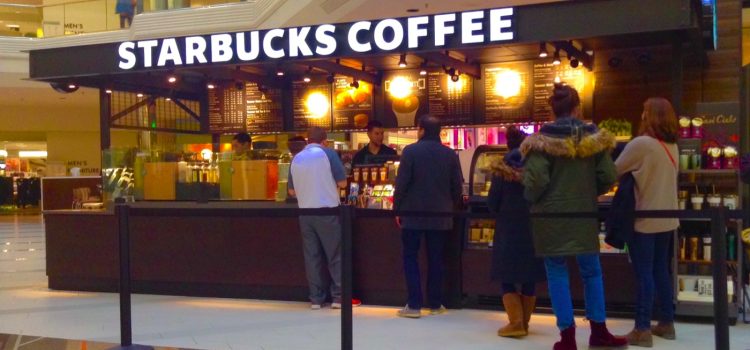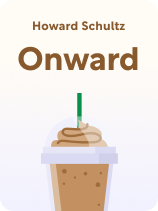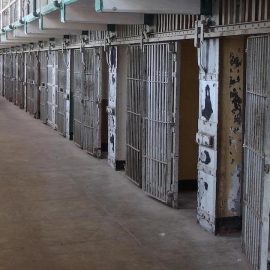

This article is an excerpt from the Shortform book guide to "Onward" by Howard Schultz. Shortform has the world's best summaries and analyses of books you should be reading.
Like this article? Sign up for a free trial here.
Why do people love Starbucks so much? What’s the customer experience at Starbucks like?
When Starbucks was in desperate need of a new business model, one of Howard Schultz’s areas of focus was customer service. Schultz made changes in three key areas: improved communication with customers, polished store design and operations, and renewed social and environmental commitments.
Let’s explore each of those areas now.
Better Communication With Customers
Schultz explains that when the email he wrote to executives detailing Starbucks’ problems was leaked in 2007, it alerted him to another concern: Starbucks was behind the times. The email exploded on social media, but Starbucks had no way to participate in that conversation because it had no social media presence at the time. To improve customer experience at Starbucks, Schultz directed the company to take two initiatives: Joining social media and creating a website called My Starbucks Idea, where customers could submit their ideas to make Starbucks better and vote on which ideas they liked best.
The My Starbucks Idea submissions told Schultz that customers, who were also experiencing the effects of the financial crisis, wanted more bang for their buck when it came to their Starbucks purchases. Starbucks had faced similar criticisms from the media, which cast Starbucks as a symbol of millennial extravagance that was inappropriate for the times. To address these issues, Starbucks rolled out customer rewards programs that gave customers access to free items and discounts, which helped incentivize in-store spending despite the struggling economy.
| How Entering the Information Age Improved Starbucks’ Customer Service Schultz explains that Starbucks opened up communication with customers by joining social media and creating its My Starbucks Idea website. By taking these steps, Schultz helped Starbucks enter what experts like Carlota Perez (Technological Revolutions and Financial Capital) call the Information Age: an era marked by the innovation of new technologies that digitize important parts of life, like sharing information and communicating with others over social media. Let’s explore some of the ways entering the Information Age helped Starbucks improve customer service. According to Gary Vaynerchuck (Jab, Jab, Right Hook), it’s strategic for companies to maintain a social media presence because social media provides countless far-reaching marketing opportunities, and taking advantage of these opportunities helps you stay relevant and competitive. Some experts say Starbucks has perfected social media marketing since it first entered the Information Age. To illustrate, consider viral Starbucks trends on TikTok, where users promote little-known Starbucks products for free to a massive audience. Additionally, creating the My Starbucks Idea website enabled Starbucks to leverage open innovation—a business management model that pulls innovative ideas and technologies from outside sources—in a novel way. Most often, open innovation requires consulting other companies, but by interfacing directly with customers, Starbucks could find out and deliver exactly what customers wanted. Over the years, some of the ideas customers proposed using the website—including free wifi, cake pops, and pumpkin spice lattes—have become staples of the Starbucks experience. The joy customers derive from these treats continue to fuel their spending at the company, despite the post-pandemic economic crunch and downgraded customer rewards. |
Polished Store Design and Operations
Schultz explains that in addition to its lack of a social media presence, Starbucks was behind in other ways. For one thing, it was using outdated technology that was clunky and cumbersome, which slowed down customer service and impeded employees from forming relationships with customers. To address this issue, Schultz gave each store a new laptop and acquired two new machines: the semiautomatic Clover, which created flavorful cups of brewed coffee and could be used to expand Starbucks’ repertoire of customizable brewed coffee drinks, and the semiautomatic Mastrena, which created espresso drinks and was sized so that employees could more easily interact with customers while making their drinks.
Schultz was also displeased with the design of Starbucks stores because they didn’t create the warm atmosphere needed for a successful third place. To fix this, Schultz rehired a former head of store development whom he considered a true innovator to redesign Starbucks stores. The new designs were centered around sustainability and featured eco-friendly elements like energy-efficient lighting and salvaged wood. Schultz also opened two experimental coffee shops that were as different as possible from the Starbucks brand in every way (including store names, menus, operating procedures, and designs). This enabled Starbucks to experiment with potential future directions in a safe way, without making major changes to Starbucks’ brand.
Additionally, Schultz decided to experiment with a new management technique he calls the “Lean program.” The Lean program involved asking employees to take the initiative to solve problems they observed in their stores, rather than only acting on top-down operating instructions from Starbucks’ corporate headquarters. This management method was tested in a few stores, where it resulted in significant improvements in both customer and employee satisfaction. Some changes that employees made to their local stores as part of this program were even scaled nationwide—for example, Starbucks changed its guidelines for how often to brew new coffee based on one store’s experimentation with this process.
Renewed Social and Environmental Commitments
Schultz explains that one reason customers had been drawn to Starbucks throughout its history was its commitment to social and environmental responsibility. To stay relevant with regard to these issues, Schultz renewed Starbucks’ commitments to Conservation International (a nonprofit dedicated to fighting climate change) and Fairtrade (which encourages ethical supply chain practices).
Starbucks also took on two social initiatives. First, the company leveraged its new social media presence to promote an advertising campaign offering free coffee for anyone who voted in the 2008 presidential election, in which only half of eligible voters were predicted to participate. (Due to voting laws, Starbucks had to change their plan and give free coffee to anyone who asked on election day, not just voters.) As a result, more than twice the usual number of customers entered Starbucks stores that day.
Second, Starbucks partnered with Heifer International, a nonprofit that alleviates poverty by distributing livestock to subsistence farmers worldwide. This partnership began when Schultz visited coffee farmers in Rwanda, learned how important livestock are in the lives of people living below the poverty line, and was inspired to involve his company in making a difference.

———End of Preview———
Like what you just read? Read the rest of the world's best book summary and analysis of Howard Schultz's "Onward" at Shortform.
Here's what you'll find in our full Onward summary:
- Why Starbucks CEO Howard Schultz left and later returned to the company
- Schultz’s three-part strategy that saved Starbucks from potential ruin
- Why millions of people love Starbucks’ coffeehouse experience






